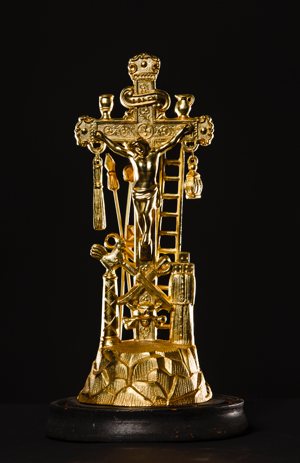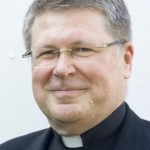
St. Thomas
The oldest known image of Jesus on the cross dates to approximately 200 A.D., but it isn’t an image of salvation. It’s a lampoon of the crucifixion — Roman graffiti showing a man worshiping a crucified figure with a donkey’s head. An inscription with the sketched image reads, “Alexamenos worships his God,” mocking a Christian man named Alexamenos.
Despite its blasphemy, the “Alexamenos graffito” reveals the association pagans made between Jesus’ crucifixion and early Christians, said Father Jan Michael Joncas, University of St. Thomas artist in residence and research fellow for the Center for Catholic Studies since 2013. The importance of the crucifixion as an image has grown over the centuries, he said, from a time when the cross was an instrument of torture and shame to a symbol of not only Christ’s death and mankind’s salvation, but also of Catholicism itself.
Father Joncas will present on the crucifix’s development as an object of art and devotion 6:30 p.m. Feb. 6 in “Salve Sancta Crux,” or “Hail, O Holy Cross,” the 2017 Master of Arts in Catholic Studies Thought and Culture Lecture. The lecture, which is given annually by a member of the Catholic Studies faculty, will be presented in partnership with St. Thomas’ Department of Art History and Office for Mission.
Father Joncas’ presentation will include crucifixes from a collection Father Dennis Dease donated to St. Thomas upon his 2013 retirement as the university’s president. The collection includes 47 crucifixes that Father Dease obtained in his travels or received as gifts.
A composer and longtime theology instructor, Father Joncas plans to highlight three from the collection, weaving them into an overview of the evolution of the crucifix’s use and representation in Christian imagery.
He hopes attendees take away a fascination with “how the representations of the crucifixion express changing understandings of salvation and changing understandings of culture,” he said.
If you goWhat: “Salve Sancta Crux,” or “Hail, O Holy Cross: Representations of the Crucifixion from the Father Dease Art Collection,” the 2017 Master of Arts in Catholic Studies’ Thought and Culture Lecture presented by Father Jan Michael Joncas
When: 6:30 p.m. Feb. 6
Where: Woulfe Alumni Hall, Anderson Student Center, University of St. Thomas, 2115 Summit Ave., St. Paul
The event is free but RSVP is required. For more information, visit University of St. Thomas events page.
From jewels to wounds
By the fifth century, crucifixion was outlawed in Rome and Christians began to use the cross in art. Among its earliest forms is the “crux gemmata,” a cross embellished not with the body of Christ, but jewels. The form reached its zenith in the 10th century, Father Joncas said, with crosses made from precious materials studded with actual jewels.
“This instrument of shame and torture is now being presented as this glorious portal into redemption,” Father Joncas said.
The earliest Christian representations of the crucifix — distinguished from a simple cross by the inclusion of Jesus’ body — date to the sixth or seventh century, Father Joncas said. What’s interesting, he noted, is that artists didn’t try to represent the crucifixion as a historical event, but rather aimed to convey its meaning. These early crucifixes show Christ as a high priest — alive and fully robed.

After Christians went through the Great Schism in 1054, Eastern Orthodox iconography continued to focus on this triumphant representation, Father Joncas said. In the Western Church, however, Franciscan spirituality — with its emphasis on Jesus’ humanity — influenced a shift in the crucifix’s focus. Jesus’ sacrifice became central, and crucifixes began to include Jesus’ wounds, sometimes accompanied by the objects of his torture such as the crown of thorns, spear and sponge.
The form reached its high point in the late Renaissance, Father Joncas said, pointing to the crucifixion scene in the Isenheim Altarpiece in France. The masterpiece of Matthias Grünewald, the scene shows a dead Christ, open mouthed with pocked greenish skin, bloody wounds and hands with fingers wrenched toward heaven. Father Joncas called it “absolutely terrifying.”
“For me, that’s the pinnacle of the suffering Christ,” he said.
Visual theology
After the Reformation, Catholics continued to show the body of Christ on the crucifix, but Protestants turned toward an empty cross. They wanted to show that it is the Risen Lord who is available to Christians, and that it is through Scripture, not visual meditation, that man comes to know God, Father Joncas said. The crucifix then began to be recognized as a mark of Catholicism, although Anglicans, Episcopalians and Lutherans use crucifixes as well.
Father Joncas plans to distinguish between crucifixes used for public worship and private devotion. Father Dease’s collection includes a detailed example of the latter, he said, pointing to a 19th-century house altar that includes tiny symbols of the crucifixion for personal meditation.
Father Joncas will also explore modern and contemporary depictions of the crucifix that highlight the idea of the “cosmic Christ” St. Paul writes about in his letters to the Galatians and Ephesians, which suggests that “the implications of redemption don’t simply affect humans, but are manifestations of God’s intention for the entire universe,” Father Joncas said.
In addition to deepening audience members’ historical understanding of the crucifix, Father Joncas hopes the images inspire conversion — “that they [audience members] would come to a new and deeper understanding of the mystery of the crucifixion.”
He thinks that goal is entirely possible.
“Art is subtle,” Father Joncas said. “It sometimes seizes the heart before the brain even knows.”




